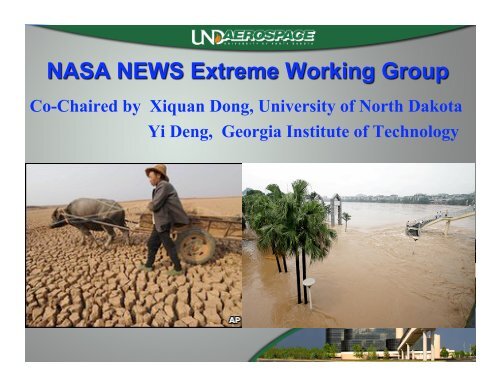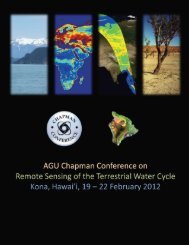Extremes WG Update - NEWS (The NASA Energy and Water cycle ...
Extremes WG Update - NEWS (The NASA Energy and Water cycle ...
Extremes WG Update - NEWS (The NASA Energy and Water cycle ...
You also want an ePaper? Increase the reach of your titles
YUMPU automatically turns print PDFs into web optimized ePapers that Google loves.
Goal: use GOES retrieved microphysicsfor different cloud types to improvesatellite-derived precipitation productfrom deep convective systemsApproach:– Use hybrid classification (Feng et al. 2011)from radar <strong>and</strong> GOES satellite to evaluatesatellite-derived precipitation product againstrain gauges (ground truth)– Find insights from GOES retrievedmicrophysics for different cloud types– Preliminary results for demonstrationHybrid ClassificationCCS Rain Fall
Mesonet Rain %CCS Rain %
An Integrative study of SGP extremes using WRF, NARR, MERRASantanello, J. A. et al., C. Peters-Lidard, S. Kumar, A. Kennedy, <strong>and</strong> X. Dong: Diagnosing the Nature of L<strong>and</strong>-Atmosphere Coupling During the 2006-07 Dry/Wet <strong>Extremes</strong> in the U. S. SGP. J. Hydromet., in prep.2006-07 <strong>Extremes</strong>(1) NARR anomalies (Fig. 1)(2) NARR used as init/bdyconditions for LIS-WRF casestudies (14-20 July 2006;14-20 June 2007)(3) LoCo diagnostics (e.g. Fig. 2)evaluated at the local (LIS-WRF), regional (NARR) <strong>and</strong>global (MERRA) scalesSensible Heat (-) PBL Height 925-mb RH20062007
This study focuses on identifying extremewarm season (April-September) rain eventsover the central US Great Plains (100°-95°W<strong>and</strong> 35°-45° N) using <strong>NASA</strong>’s multi-satellitemeasurements (TRMM-3B42) <strong>and</strong>underst<strong>and</strong>ing atmospheric processesassociated with these events using NorthAmerican Regional Reanalysis (NARR)Extreme Event: When daily rain amount exceeds95 percentile value from 2000-2009 daily rainmeasurements (spatial resolution:approximately 25x25 km 2 area) within the USGPExtreme Rain Frequency: Number ofdaysexceeding the 95 percentile valueNorthward wind at 925 hPa level(top) <strong>and</strong> eastward wind at 200hPa (bottom) from NARR(Difference between 2008 <strong>and</strong> 2006April-September seasonal values)Figure 1: 95 percentile value > 35 mm/day over eastern Great Plains with muchlarger values (> 50mm/day) oversoutheastern regionFigure 2: Extreme warm season rainfrequency over the last decade rangefrom 1-10 days exhibit spatialcoherence <strong>and</strong> substantial inter-annualvariabilityOn the average extreme rain eventscover 1-2% area of the USGP per day<strong>The</strong> rain frequency was minimum in2006 <strong>and</strong> maximum in 2008Figure 3: Eastward shift in lowlevelnorthward wind jet (top) <strong>and</strong>southward shift in upper leveleastward wind jet (bottom) in2008 compared to 2006 suggestlarge-scale dynamical controls onthe extreme rain frequency overthe USGPAmita Mehta <strong>and</strong> Eric Smith amita.v.mehta@nasa.govThis study is supported in part by <strong>NASA</strong><strong>Energy</strong> <strong>and</strong> <strong>Water</strong> Cycle Studies Program<strong>The</strong>me: Drought <strong>and</strong> Flood <strong>Extremes</strong>
<strong>NASA</strong> MERRA Revealed Dynamical Organization of the North Pacific AtmosphericRiver Activity by East Asian Cold Surge EventsPrincipal Investigator: Yi Deng (yi.deng@eas.gatech.edu)Atmospheric Rivers (ARs) are narrow regions of intense moisture transport in the troposphere that account for approximately 90% of the totalmeridional moisture transport in the extratropics. <strong>The</strong>y are a primary feature of the global water <strong>cycle</strong> <strong>and</strong> are closely tied to water supply <strong>and</strong> floodrisk in the western U.S. With the <strong>NASA</strong> MERRA data, this study for the first time revealed that the occurrence frequency of ARs over the easternNorth Pacific is modulated by the East Asian cold surge events in wintertime. <strong>The</strong> circulation <strong>and</strong> wind anomalies dynamically excited by the lowtemperaturesof cold surge propagate eastward across the North Pacific <strong>and</strong> 3 to 5 days later create an environment favorable for the formation of ARsthat can potentially make l<strong>and</strong>fall at the U.S. west coast. East Asian cold surge thus serves as a remote forcing for the western U.S. hydrologicalextremes. This newly identified forcing provides additional dynamical ground for subseasonal prediction of AR activity as well as observationalbenchmark for climate model evaluation. <strong>The</strong> connection between an energy <strong>cycle</strong> feature (temperature extremes) <strong>and</strong> a water <strong>cycle</strong> feature(hydrological extremes) discovered here shows the unique role the <strong>NASA</strong> <strong>NEWS</strong> played in integrating research efforts in the global energy <strong>cycle</strong> <strong>and</strong>water <strong>cycle</strong>.(a)Atmospheric river(a) (b) (c)(b)Atmospheric riverFigure 2: Height anomalies (color shading, unit: m/k) <strong>and</strong> water vapor transport anomalies (vector, unit: m/s/k) on850mb level 3 days (a), 4 days (b) <strong>and</strong> 5 days (c) after the peak of an East Asian cold surge event. All variables have beennormalized by the temperature drop associated with the cold surge. Note the intense moisture transport over westernNorth America associated with the negative (cyclonic) height anomalies that are originally excited by the cold surgeover East Asia.(c)Atmospheric riverFigure 3: Changes in the occurrence probability ofAR over the North Pacific 3-5 days after an EastAsian cold surge event. Note the significant rise ofthe occurrence chance of AR along the U.S. westcoast.Figure 1: Three Atmospheric River (AR) events((a) 10/13/2009, (b) 11/07/2006, (c) 01/09/2005) thatproduced extreme precipitation along the U.S. westcoast as detected from the column integrated totalwater vapor (TQV) field of the <strong>NASA</strong> MERRA.Unit: mm.Figure 4: Evolution of the total water vapor (TQV) anomaly westof the U.S. coastline after the peak of an East Asian cold surgeevent (lag day 0). Note the significant rise of the level of TQValong the U.S. west coast due to the formation of ARs over theeastern Pacific around lag day 3 (see Figure 2 above). Unit: mm/k (TQV anomaly has been normalized by the temperature dropassociated with the cold surge ).
A Study of Arctic Clouds <strong>and</strong> Radiation Budget Supported by <strong>NASA</strong> <strong>NEWS</strong> ProjectDong, X., B. Xi, K. Crosby, C.N. Long, R. Stone <strong>and</strong> M. Shupe, 2010: A 10-yr Climatology of ArcticCloud Fraction <strong>and</strong> Radiative Forcing at Barrow, Alaska. J. Geophys. Res., 115, D17212,SWLWNETArctic cloud Fraction increases significantly fromMarch to May (0.57→0.84), remain relatively high(~0.80-0.9) from May to October, <strong>and</strong> then decreasefrom November to the following March (0.8→0.57),having an annual average of 0.76.On annual average, the negative SWCRFs <strong>and</strong> positive LW CRFs nearlycancel, resulting in annual average NETCRF of about 3.5 Wm -2 on the basis of thecombined ARM <strong>and</strong> BRW analysis.
<strong>NEWS</strong> Publication HighlightBaike Xi, Xiquan Dong, Pat Minnis <strong>and</strong> M<strong>and</strong>y Khaiyer, A 10-yr climatology of cloud fraction <strong>and</strong> verticaldistribution derived from both surface <strong>and</strong> GOES observations over the DOE ARM SGP site, J. of Geophys. Res.,115, D12124, doi:10.1029/2009JD012800, 2010 (Published: 29 June 2010)FREQAWPFREQFREQ increases <strong>and</strong> AWP decreases withtemporal res., but CF is independent oftemporal <strong>and</strong> spatial resolution.Mean vertical distributions of CFincrease with vertical resolutions of 90m, 250 m, 500 m, <strong>and</strong> 1000 m.
Yi Deng Group <strong>NEWS</strong> Publications1. Deng, Y., T. Jiang, X. Dong, <strong>and</strong> B. Ling: Dynamical Organization of the Western U.S. AtmosphericRiver Activity by Extreme East Asian Cold Surge Events. Journal of Geophysical Research(Under preparation).2. Hegyi, B. <strong>and</strong> Y. Deng, 2011: A dynamical fingerprint of tropical Pacific sea surface temperatures inthe decadal-scale variability of the cool-season Arctic precipitation (Under revision).3. Deng, Y. <strong>and</strong> T. Jiang, 2011: Intraseasonal Modulation of the North Pacific Storm Track by TropicalConvection in Boreal Winter. Journal of Climate, 24, 1122-1137.4. Li, W., L. Li, R. Fu, Y. Deng <strong>and</strong> H. Wang, 2011:Changes to the North Atlantic Subtropical High<strong>and</strong> Its Role in the Intensification of Summer Rainfall Variability in the Southeastern United States.Journal of Climate, 24, 1499-1506.5. Dong, X., B. Xi, A. Kennedy, Z. Feng, J. K. Entin, P. R. Houser, R. A. Schiffer, T. L'Ecuyer, W. S.Olson, K. Hsu, W. T. Liu, B. Lin, Y. Deng <strong>and</strong> T. Jiang, 2011: Investigation of the 2006 Drought <strong>and</strong>2007 Flood <strong>Extremes</strong> at the Southen Great Plains Through an Integrative Analysis of Observations.Journal of Geophysical Research, 116, D03204, doi:10.1029/2010JD014776.6. Myoung, B. <strong>and</strong> Y. Deng, 2009: Interannual Variability of the Cyclonic Activity along the U.S.Pacific Coast: Influences on the Characteristics of Winter Precipitation in the Western U.S. Journal ofClimate , 22, 5732-5747.14
Other PIs <strong>NEWS</strong> Publications1. Lin et al. Inter. J. Remote Sensing, 31, DOI: 10.1080/01431160903548005, 2010.2. Santanello, J. A. et al., C. Peters-Lidard, S. Kumar, A. Kennedy, <strong>and</strong> X. Dong: Diagnosing theNature of L<strong>and</strong>-Atmosphere Coupling During the 2006-07 Dry/Wet <strong>Extremes</strong> in the U. S. SGP. J.Hydromet., in prep.3. Santanello, et al. (2009). "A Modeling <strong>and</strong> Observational Framework for Diagnosing Local L<strong>and</strong>-Atmosphere Coupling on Diurnal Time Scales." Journal of Hydrometeorology 10(3): 577-599.4. Porporato, A. (2009). "Atmospheric Boundary-Layer Dynamics with Constant Bowen Ratio."Boundary-Layer Meteorology 132(2): 227-240.5. Eyal Amitai, W. Petersen, X. Llort, <strong>and</strong> S.Vasiloff ,( 2011) Multi-Platform Comparisons of RainIntensity for Extreme Precipitation Events.15
Near-term Goals for Extreme working Group16
<strong>The</strong> frequency of extreme precipitation events will approximatelyincrease by 26%, predicted by 21 GCMs if the globaltemperature increases 2.5 o C at the end of 21 st Century. However, most GCMs’ simulation of extreme events isproblematic due to the limitation of resolution, imperfectrepresentation of sub-grid scale processes <strong>and</strong> lack of realisticamplitude of natural variability given the model tuning beingfocused on getting the mean <strong>and</strong> simple st<strong>and</strong>ard variationcorrect To facilitate climate modelers’ efforts in simulating historicalextreme events <strong>and</strong> deriving predictability of characteristics ofhydrological extremes in the future, we will provide amultivariate, global database of hydrological extreme eventsbased primarily on <strong>NEWS</strong> Phase I Data Building Effort.17
Probability of extremes increases in a warmer climateMore days with light Precip (Drought) <strong>and</strong> heavy Precip (Flood)18
Method:1) Calculate monthly means <strong>and</strong> st<strong>and</strong>ard deviations of precipitationduring the period 1979-20102) Calculate each month mean precipitation <strong>and</strong> its anomaly againstclimate mean.Index =Anomaly____St<strong>and</strong>ard DeviationIndex < -1 DroughtIndex > 1 Flood
Index












